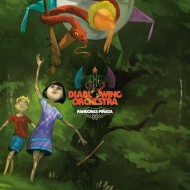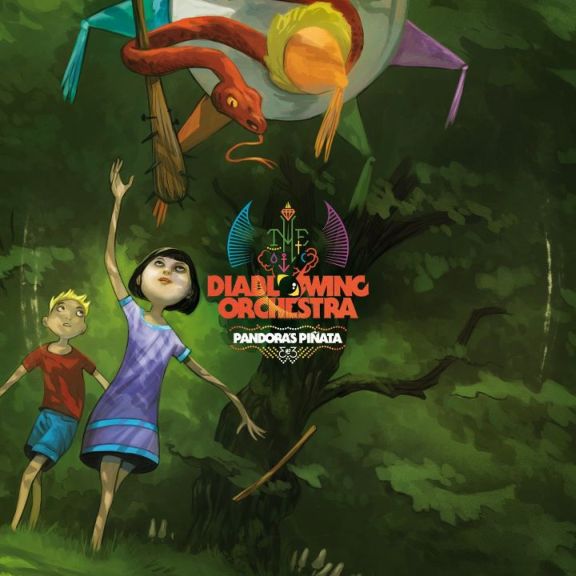 A controlled riot is upon us. 18 musicians contributed to this album, with 8 taking part in the live shows. Diablo Swing Orchestra are back with their third album “Pandora’s Piñata”. A piñata is a brightly coloured figure which children break open to release a variety of sweets. Multi-coloured and full of variety are words to describe Diablo Swing Orchestra’s music. Panem et circenses – let’s entertain the masses and while we’re about it, there’ll be no boundaries. All the usual qualities are on this album: swing jazz metal, toe-tapping rhythms, operatic bombast, rich cello sounds, mariachi and general merriment. And that’s just the first track “Voodoo Mon Amour”.
A controlled riot is upon us. 18 musicians contributed to this album, with 8 taking part in the live shows. Diablo Swing Orchestra are back with their third album “Pandora’s Piñata”. A piñata is a brightly coloured figure which children break open to release a variety of sweets. Multi-coloured and full of variety are words to describe Diablo Swing Orchestra’s music. Panem et circenses – let’s entertain the masses and while we’re about it, there’ll be no boundaries. All the usual qualities are on this album: swing jazz metal, toe-tapping rhythms, operatic bombast, rich cello sounds, mariachi and general merriment. And that’s just the first track “Voodoo Mon Amour”.
The mixture of sounds is rich. The funky trumpet and rhythm of “Guerilla Laments” suggests a vision of Mexicans with ponchos and a propensity to Latin-American music but in truth there isn’t a propensity here to anything other than making sure the party goes on. But then there’s a sophisticated side. Operatic singer Annlouice Loegdlund’s sweet voice shines on “Kevlar Sweethearts” and on “Aurora”, which manages to be highbrow and dramatic in the vein of a key song from a musical. It is supported by a subtle and ticking soft rhythm before the song develops a distinctly Arabic air. Her voice and the classical tone of “Of Kali Ma Calibre” have all the ingredients of a more serious track but there’s a mock pomposity about it. The drums beat furiously and with the aid of the strings, the level of majesty is heightened and it becomes like a march.
Although we’re never far from the chunky cello and irrepressible cadence, there’s nothing standard about this work. Inspiration comes from everywhere. “Mass Rapture” arises out of “Aurora” with a Hindi rhythm, which itself develops into the customary toe-tapping beat. This hypnotic track has the mysterious air of the night about it. Cleverly Ms Loegdlund is left out of it until the end when she joins in to raise the already exotic air. Compared to the two previous albums, there’s more of a serious side. The funk jazz orientated, trumpet-infused “Honey Trap Aftermath” is more sober than we have previously been used to, but the humour returns at the end with a spot of Gospel a capella to round it off.
Diablo Swing Orchestra’s songs have always been clever but “Justice for Saint Mary”, which closes the album, is a particularly professionally constructed piece. The strings provide the backdrop for a classical acoustic song. The strings dominate and create both majesty and a rich melancholy. In spite of the typically delicate and silky vocals from Pontus Mantefors, who puts in another great performance on this work, “Justice for Saint Mary” is dark and sinister, and has the feel of a soundtrack. The melancholic and dramatic orchestral sound cranks up with the aid of a heightened drum beat but eventually gives way though, and the track degenerates into a mind-distorting sound passage of electro scratching. With Diablo Swing Orchestra I should have known to expect the unexpected.
“Pandora’s Piñata” has more of a serious face and features less eccentric themes than previous works but there’s still plenty of enjoyment and fun to be had. “Exit Strategy of a Wrecking Ball” is more what we have become accustomed to – metal rhythms combining with the forward-thrusting cello, exaggerated drama, a bit of classical music, trumpets to the fore before a bit of heaviness prevails and the trumpets return. In spite of all this action, I found it a bit flat, as if Diablo Swing Orchestra were going through the motions. Strangely I had the same impression after hearing the first two of three tracks on the album. Although good, the sound was a bit desultory and like an aural illusion it was only after hearing the album from the seventh track “Aurora” that I started to open my mind and appreciate its many finer points, including the earlier tracks. Where the band is at their best is when they deliver an original idea, as they do on “Mass Rapture” and “Black Box Messiah”. Before “Black Messiah” is the enigmatically-titled “How to Organise a Lynch Mob”, which sets the scene. The electric tone of the cello plays out a sad tune, whose mood could emanate from the mountains and mists ofChina. Of course sadness is not part of Diablo Swing Orchestra’s repertoire, and any such nonsense is dispelled immediately in “Black Messiah”. Its bouncy chorus sounds like a group of Chinese or maybe Japanese schoolchildren have been hired for the occasion. The track remains in catchy forward thrust to the end when the sad-sounding cello tune reappears and rounds off this section nicely.
So once again credit is due to Diablo Swing Orchestra for taking us by surprise and treating to us to a world tour of music, all mixed up with their own unmistakeable brand of swing metal. As with its predecessors, there are parts where you can still tap your foot, headbang, have a laugh, feel it and move along to it. “Pandora’s Piñata” is always imaginative, and the fusion of styles will always be unique. But there’s an undercurrent too. Overall it is more sober, and there is less sustained mayhem and anarchy. Is this the price for being more professional or just a change of style into something more serious? I must confess that I had more difficulty latching onto this album as a whole than I did with “The Butcher’s Ballroom” or “Sing-Along Songs for the Damned and Delirious”. Even so, I recognise “Pandora’s Piñata” as another work of great creativity and originality.
(7.5 / 10 Andrew Doherty)

15/11/2012 at 6:13 pm
Very nice article. I’d like to say though that I really love Exit strategy of a wrecking ball and that I do not find it flat in the slightest !